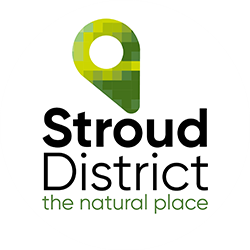The Great Eight - our local areas
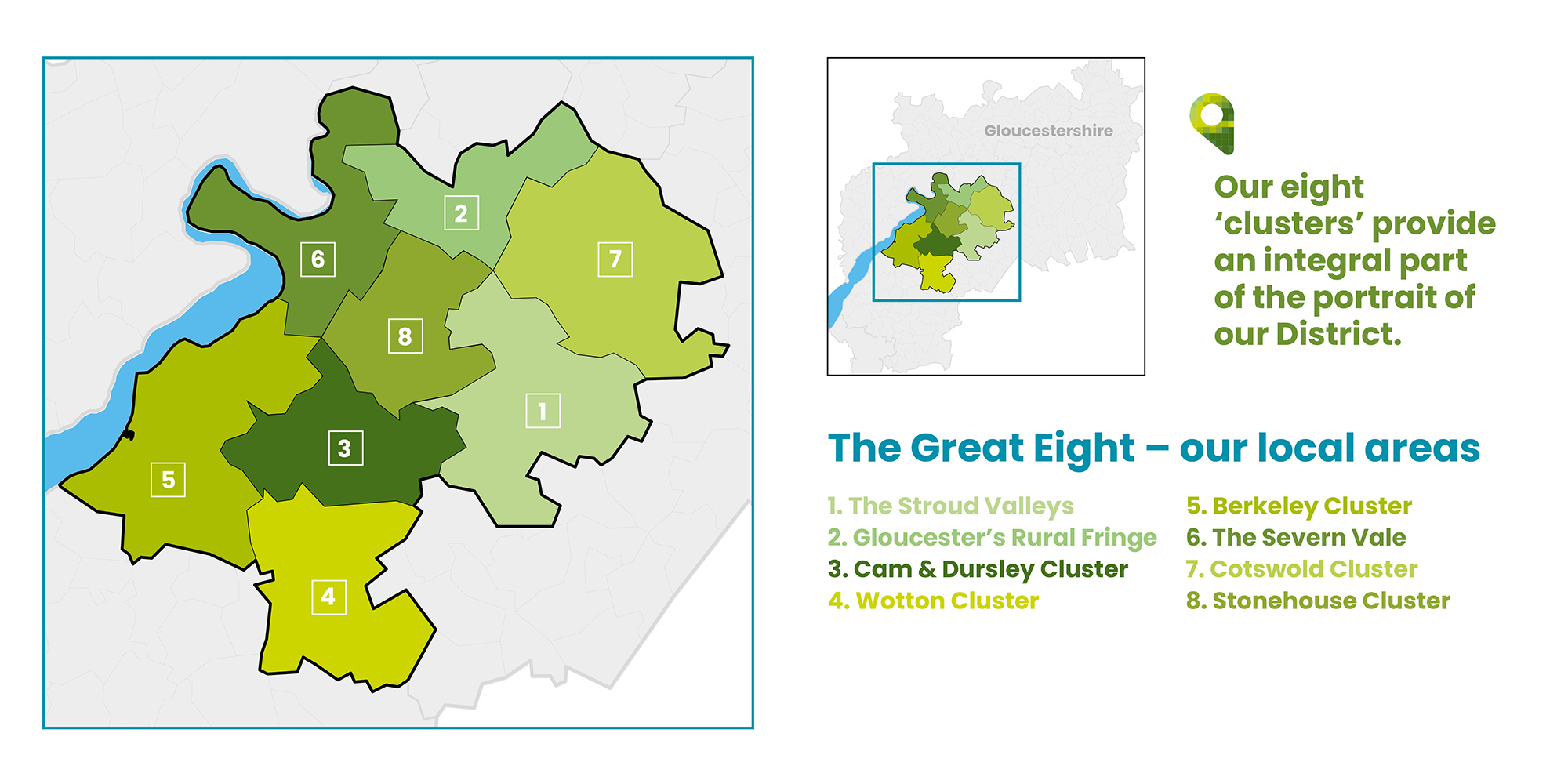
Stroud District encompasses towns, villages and more sparsely populated rural areas, each with distinct personalities and qualities. We have grouped these areas into eight ‘clusters’. You can learn about them here.
1. The Stroud Valleys
 The Valleys are home to around 49,000 people (just over 40% of the district’s population), including just under 6,000 in the town of Nailsworth. Stroud town is the district’s largest commercial centre, with a population of 13,500. It needs to continue to evolve and develop to compete with larger retail and leisure offerings including Bristol, Cheltenham, Gloucester and Cirencester.
The Valleys are home to around 49,000 people (just over 40% of the district’s population), including just under 6,000 in the town of Nailsworth. Stroud town is the district’s largest commercial centre, with a population of 13,500. It needs to continue to evolve and develop to compete with larger retail and leisure offerings including Bristol, Cheltenham, Gloucester and Cirencester.
Stroud’s independent retail scene, farmers markets and cultural programme bring its personality and spirit to life. Regeneration projects including the canal restoration and a town centre focus will support the town to fulfil its potential.
In 2021, the Sunday Times named Stroud the best place to live in the UK, praising the town's many green spaces, its independent spirit, and quality schools.
2. Gloucester's Rural Fringe
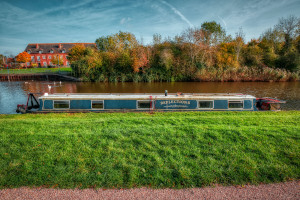 Almost half of this area is part of the Cotswolds Area of Outstanding Natural Beauty and there are dramatic and far-reaching views to and from the Cotswold escarpment.
Almost half of this area is part of the Cotswolds Area of Outstanding Natural Beauty and there are dramatic and far-reaching views to and from the Cotswold escarpment.
Most people here live on the edge of the Gloucester urban area, at Hardwicke and in growing new communities at Hunts Grove and Cooper’s Edge. After Hardwicke, Upton St Leonards is the second largest settlement on the Gloucester fringe. The villages of Haresfield and Brookthorpe and scattered hamlets and farms make up most of the other parishes.
All the district’s major routes north (road and rail, as well as the Gloucester & Sharpness canal) pass through this area. Over the district boundary, there is significant employment growth in Gloucester City, including at Waterwells Business Park.
3. Cam & Dursley Cluster
 Towards the south of the district lie the village of Cam and town of Dursley (population approximately 15,000), which jointly act as a focus for the southern part of the district. Both well connected, Cam and Dursley have a rail station on the Bristol-Birmingham main railway line.
Towards the south of the district lie the village of Cam and town of Dursley (population approximately 15,000), which jointly act as a focus for the southern part of the district. Both well connected, Cam and Dursley have a rail station on the Bristol-Birmingham main railway line.
Dursley is Stroud District’s second town centre and, as adjacent settlements, Cam and Dursley together represent an important hub for homes, jobs and services. Dursley is surrounded by beautiful landscapes, much of it with an Area of Outstanding Natural Beauty designation.
There is an active Transition group in Cam and Dursley (part of the global Transition Town network increasing self-sufficiency) which looks after projects including Dursley's Secret Garden, a community garden in the centre of the town.
4. Wotton Cluster
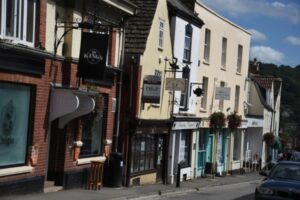 A walker's paradise, this is a largely rural area on the western escarpment of the Cotswolds, overlooking the Severn Vale. Wotton-under-Edge sits on a ledge below the Cotswold Escarpment and is crossed by the Cotswold Way national trail and Monarchs Way long distance path. The centre of the town, one of the district’s former market towns, is a Conservation Area and sits within the Cotswolds Area of Outstanding Natural Beauty.
A walker's paradise, this is a largely rural area on the western escarpment of the Cotswolds, overlooking the Severn Vale. Wotton-under-Edge sits on a ledge below the Cotswold Escarpment and is crossed by the Cotswold Way national trail and Monarchs Way long distance path. The centre of the town, one of the district’s former market towns, is a Conservation Area and sits within the Cotswolds Area of Outstanding Natural Beauty.
Surrounding villages and hamlets look towards Wotton-under-Edge as a local service centre. Renishaw Ltd is a major employer, based just outside the village of Kingswood. It’s within easy commuting distance to Thornbury, Yate and Bristol, and the town itself is also commercially active. There are a good range of shops and services in the town including a local cinema and swimming pool.
5. Berkeley Cluster
 This cluster of parishes lies in the Severn Vale at the south-western corner of Stroud District, close to the boundary between Gloucestershire and South Gloucestershire. Berkeley is a historic market town, which today acts as a local service centre for a rural hinterland. It is home to the Severn Bore, a world natural wonder and Peter Scott described the wetlands of the Berkeley Vale as ‘The Avian Serengeti’ due to the huge numbers of birds found here. The harbour of Sharpness is often described as the UK’s most beautiful working port.
This cluster of parishes lies in the Severn Vale at the south-western corner of Stroud District, close to the boundary between Gloucestershire and South Gloucestershire. Berkeley is a historic market town, which today acts as a local service centre for a rural hinterland. It is home to the Severn Bore, a world natural wonder and Peter Scott described the wetlands of the Berkeley Vale as ‘The Avian Serengeti’ due to the huge numbers of birds found here. The harbour of Sharpness is often described as the UK’s most beautiful working port.
Many residents of these parishes commute out of the district for work and leisure (Bristol and Thornbury are within easy reach). The closure of Berkeley Nuclear Power Station had an impact on local employment opportunities, but the development of the Gloucestershire Science and Technology Park is providing new opportunities for growth.
Sharpness Docks is a thriving and busy port but has scope for new development focussing on the leisure and tourism potential of the Gloucester-Sharpness canal and its Severn Estuary location.
The area has beautiful landscape and valuable estuarine habitats, which are nationally and internationally protected. These parishes are also home to some of the district’s major tourist attractions: notably, Berkeley Castle, The Jenner Museum (a dig by Bristol University at Berkeley Castle discovered many Roman artefacts on display here), Cattle Country Adventure Park and the world-renowned Wildfowl and Wetlands Trust at Slimbridge.
6. The Severn Vale
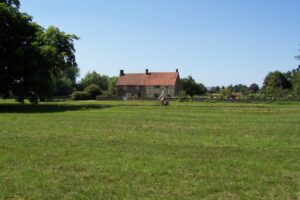 This rural area is home to small but active communities with a strong sense of local identity. The area is becoming well known for day tourism for walkers, cyclists and horse-riders.
This rural area is home to small but active communities with a strong sense of local identity. The area is becoming well known for day tourism for walkers, cyclists and horse-riders.
The farming community is strong and holdings range from medium-scale dairy, arable and beef farms to family run smallholdings.
The natural environment includes sympathetically managed agricultural land, orchards, woodland and watercourses; the Severn Estuary and its margins are home to an internationally important wildlife and habitat resource. Frampton-on-Severn has an exceptional built heritage, with a high number of listed buildings set around a very distinctive, long village green.
7. Cotswold Cluster
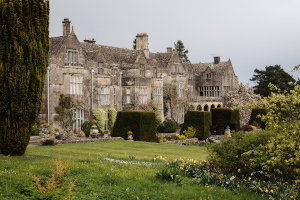 The Cotswolds are world-renowned for their landscape and the pretty limestone villages that populate it and this rural cluster of parishes falls entirely within the Cotswolds Area of Outstanding Natural Beauty.
The Cotswolds are world-renowned for their landscape and the pretty limestone villages that populate it and this rural cluster of parishes falls entirely within the Cotswolds Area of Outstanding Natural Beauty.
The popular tourist attractions Rococco Gardens, Painswick; the village of Slad and the Laurie Lee Wildlife Way; and the Garden at Miserden can all be found here.
The largest settlement here is Painswick, which lies at the heart of these rural parishes. Known as ‘The Queen of the Cotswolds’, Painswick is one of the finest and best-preserved Cotswold towns and surrounded by some of the Cotswolds' most beautiful countryside.
Painswick is at the mid-point of the Cotswold Way and surrounded by perfect walking country. The world-famous Rococo Gardens, Painswick Beacon and the villages of Sheepscombe, Edge and Slad are all close by.
8. Stonehouse Cluster
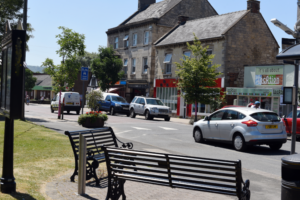 Stonehouse is the second most populated town in the district after Stroud.
Stonehouse is the second most populated town in the district after Stroud.
On its western edge lies a major industrial and business area, which provides jobs for over 4,000 people.
The town of Stonehouse lies two miles east of Junction 13 (M5), with a rail station on the main Gloucester-London line. Plans to reopen a second station as a stop on the main line to Bristol will improve links to Bristol and the South West.
